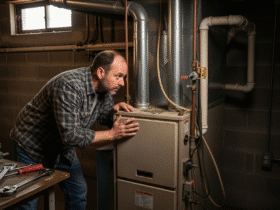Hotpoint Dishwasher Not Draining
Dishwasher Not Draining: One of the most common problems reported to plumbers by homeowners is that the dishwasher is not draining. While it can be scary to open the dishwasher door and see standing water in the bottom, it isn’t always a plumbing emergency. You may be able to correct the problem yourself without professional assistance.
Read Also: How To Plunge a Toilet
If your dishwasher isn’t draining, there are a few quick and easy checks you can make before calling in a professional or buying a new machine. Watch our video or read on below for step-by-step advice to try to fix it yourself.

Run your garbage disposal:
The drain hose from your dishwasher empties into the garbage disposal drain. If the disposal unit contains unground food, or if food sludge settles in the drainpipe below the disposal, it can prevent the dishwasher from draining properly. Sometimes, just running the disposal is all it takes to get the dishwasher draining again.
Clean your sink’s air gap:
When a dishwasher hose connects to a sink without garbage disposal, an air gap—a small, slotted cylinder (often made of stainless steel)—is installed on the top of the sink, right by the faucet. A small hose from the air gap connects to the dishwasher’s drain hose.
This acts as a vent to prevent an airlock from forming in the drain hose, but occasionally, the air gap can become clogged with debris. To investigate, twist the air gap counterclockwise to remove it, and check it for gunk. Clean the air gap with water and a stiff brush, replace it, and run the dishwasher cycle again. Also, Read – Gutter Installation Price And Process
Whirlpool Dishwasher Not Draining
There could be a few reasons why your Whirlpool is not draining, but the result is usually the same: a puddle of stagnant, smelly water at the bottom of your dishwasher. Your drain may get clogged with food or broken pieces of the wine glass your wife told you not to put in there.
If that’s the case, the job is pretty straightforward. But if your Whirlpool dishwasher is still not draining completely after carefully cleaning out the debris, you might have a bad drain valve, drain pump, or something else. Work your way through the causes below so you can get your Whirlpool back in action.
Drain Pump Isn’t Working
You could have a Whirlpool dishwasher drain pump not working if you have standing water in your dishwasher. The drain pump uses an impeller to shoot water through the drain hose. If the pump fails, that water’s not going anywhere.
Check the pump for continuity using a multimeter to determine if it is working properly. If there is no continuity, or if the power is fine but it still won’t work, then it needs to be replaced.
Drain Impeller is Broken
If you have a Whirlpool dishwasher not draining at end of the cycle and the drain pump is not to blame, the drain impeller could be broken. The impeller forces water through the drain hose. If the impeller is broken, the dirty water will remain at the bottom of the dishwasher.
Drain Valve is Clogged
A common reason why a dishwasher doesn’t drain is a clogged drain valve. When you use the dishwasher & forget to scrape food particles off, the debris gets left behind and eventually gets accumulates around the drain valve. Once the drain valve gets clogged with debris, the water can’t filter out through the drain hose. Also Read – 11 Window Measuring Mistakes + How to Avoid Them
Ge Dishwasher Not Draining
On models with a Fine and Ultra Fine filter, remove and check the Ultra Fine filter and Fine filter underneath. For more information, visit Dishwasher – How to Clean Fine and Ultra Filters.
On models without an Ultra Fine filter at the bottom of the tub, 1-2 cups of clean water covering the bottom of the tub are normal. On models with an Ultra Fine Filter, water in the sump (filter area) is normal, but should not cover the bottom of the dishwasher.

Steps To Fix Dishwasher Not Draining
Make sure there is not paper or large objects covering or blocking the sump area in the rear of the tub. Clear out large pieces of food from the bottom of the dishwasher, like noodles, lettuce, bones, etc.
Check the drain hose where it connects below the sink for blockage or a kink in the hose. New dishwashers come with a white corrugated drain hose, which should be used. Re-using old, worn-out drain hoses may promote kinking and blockage.
Make sure the kitchen sink drain is not clogged. If you install a disposer, run the disposer to clear the drain system. Do not put your hands into the garbage disposer, as serious injury could result. You should always turn on your garbage disposer before running the dishwasher, to clean out any food or debris within the drain system.
If you install an air gap, remove the cap and remove any debris found. Clearing the air gap will allow water to flow better as the dishwasher drains. For more information, see Dishwasher – Cleaning Your Air Gap.
If a disposer installed or replaced recently, make sure you removed the drain plug inside the disposer without fail. Instructions for removing the drain plug are in the disposer’s installation instructions.
Suggested – How To Build A Retaining Wall Step By Step Guide
Why Is There Standing Water In My Dishwasher?
The most common reason for a dishwasher to have standing water in it is because food debris has clogged up the drainage system within the appliance itself. When you open up the dishwasher, first remove the standing water as best you can. Then remove the bottom sprayer arm because it will just generally pop out.
How Do I Get Rid Of Standing Water In My Dishwasher?
Mix 1/2 cup of baking soda and 1/2 cup of water to form a paste. Pour the paste into the drain line through the filter screen. Pour 1/2 cup vinegar down the drain line and let the solution sit for 15 minutes. After 15 minutes, pour hot water down the drain line to flush out the baking soda solution.
What Causes Water Not To Drain From A Dishwasher?
One of the most common reasons your dishwasher might not drain properly is due to a block or clog in the drain path. This path includes the sump, pump, drain hose, and sink drain. Maybe any one of them could have trapped food particles. Or even a buildup of grease that prevents water from draining after a cycle.
Is There Supposed To Be Water In The Bottom Of The Dishwasher?
Dishwasher Water in the Bottom of the Tub. Some water (standing water), usually one to two cups, remaining in the bottom of the tub is normal. Do not plumb other devices into the dishwasher drain hose. If you don’t install an air gap, the high drain loop stops preventing backflow of water from the drain into the dishwasher.
Related – What Is Mineral Spirits?












Leave a Reply